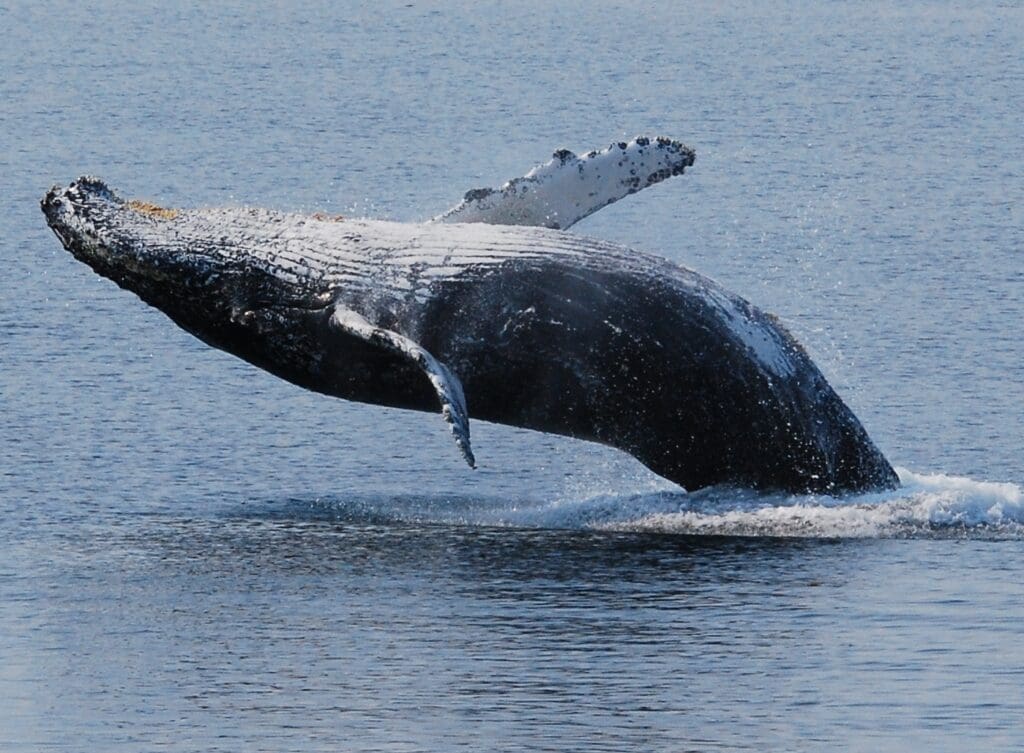I took this video while on the Alaska charter yacht ‘Midnight Sun’.
Humpback whales,
scientifically known as Megaptera novaeangliae, are magnificent marine mammals belonging to the baleen whale family, Balaenopteridae. Here’s some information about the biology of humpback whales:
- Size and Physical Characteristics: Humpback whales are one of the larger whale species, with adults measuring around 12-16 meters (39-52 feet) in length and weighing approximately 25-30 metric tons. They have a distinctive body shape with long pectoral fins or flippers, which can reach up to one-third of their body length. These flippers are marked with unique patterns of knobs, scars, and pigmentation, allowing for individual identification.
- Coloration: The body of humpback whales is predominantly black or dark gray, with a variable pattern of white or light gray on their ventral side, extending up to the flippers. This coloration provides them with effective camouflage against potential predators and prey.
- Feeding Mechanism: Humpback whales are filter feeders, and they consume vast amounts of small fish, krill, and other tiny organisms known as plankton. They possess baleen plates in their mouths instead of teeth. These baleen plates are made of a keratin material that forms a fringed structure, allowing the whales to filter out and capture large volumes of water while retaining their prey.
- Migration and Breeding: Humpback whales are known for their long-distance migrations. They typically spend their summers feeding in polar waters, accumulating energy reserves, and then undertake lengthy migrations to tropical or subtropical regions during the winter for breeding and calving. These migrations can span thousands of kilometers.
- Singing and Communication: Male humpback whales produce complex songs, which are a series of repetitive vocalizations that can last up to 20 minutes. These songs are believed to be a form of communication and are primarily associated with mating and attracting females. The songs can carry over long distances underwater.
- Population and Conservation: Humpback whales were once heavily hunted and faced severe population declines. However, since receiving international protection in 1966, their numbers have shown signs of recovery. Today, they are listed as a species of least concern by the International Union for Conservation of Nature (IUCN). Conservation efforts continue to protect their habitats and ensure sustainable practices.
- Lifespan and Behavior: Humpback whales have a lifespan of approximately 45-50 years. They are known for their acrobatic behavior, often breaching (leaping out of the water) and slapping their flippers or tails on the surface. These behaviors serve various purposes, including communication, courtship displays, and possibly removing parasites.
It’s important to note that while humpback whales are fascinating creatures, the field of marine biology continually uncovers new information about their biology and behavior.
Humpback whales are magnificent creatures that can be found in Southeast Alaska. This region is renowned for its rich marine ecosystem, which attracts humpback whales during their feeding season. Here’s some information about humpback whales in Southeast Alaska:
- Migration: Humpback whales are known for their remarkable migrations. They undertake long journeys from their breeding grounds in warm tropical waters, such as Hawaii or Mexico, to colder feeding grounds like Southeast Alaska. These migrations can span thousands of miles and occur annually.
- Feeding: Humpback whales in Southeast Alaska primarily feed on small fish, such as herring and salmon, as well as krill and other planktonic organisms. The region’s nutrient-rich waters provide an abundant food source, supporting the humpback whale population.
- Behaviors: Humpback whales are known for their acrobatic displays, which include breaching (leaping out of the water), tail slapping, pectoral fin slapping, and bubble-net feeding. Bubble-net feeding is a cooperative feeding technique where a group of whales creates a ring of bubbles around a school of fish, herding them into a tight ball and then lunging through the center to feed.
- Whale Watching: Southeast Alaska is a popular destination for whale watching due to its large humpback whale population. Visitors can embark on boat tours or cruises specifically designed to observe these majestic creatures in their natural habitat. Several areas, such as Juneau, Sitka, and the Inside Passage, offer excellent opportunities to witness humpback whales up close.
- Conservation: Humpback whales were once severely depleted due to commercial whaling, but they have made a significant recovery since the establishment of international protection measures. In Southeast Alaska, efforts have been made to protect humpback whales and their habitats through regulations and conservation initiatives, ensuring their continued presence in the region.
Bubble net feeding by humpback whales
Bubble net feeding is a unique feeding behavior exhibited by humpback whales (Megaptera novaeangliae). It is a cooperative feeding strategy where a group of whales work together to corral and capture schools of fish or krill.
Here’s how bubble net feeding typically works:
- Bubble Net Formation: A group of humpback whales, usually consisting of several individuals, locates a dense concentration of prey, such as fish or krill, near the water’s surface. They start by swimming in a circular pattern beneath the prey, blowing bubbles as they swim. This action creates a “net” of bubbles that rise to the surface, forming a cylindrical shape.
- Vocalizations and Coordination: While forming the bubble net, the whales emit a series of vocalizations, including songs and complex calls. These vocalizations likely serve to communicate and coordinate the feeding behavior among the group.
- Diving and Encircling: Once the bubble net is created, the whales dive below the prey, swimming in a spiraling motion while staying beneath the bubble net. This spiraling motion effectively herds the prey into a concentrated mass.
- Surfacing and Feeding: As the whales swim upward, they continue releasing bubbles, creating a barrier that confines the prey within a tighter area. The whales then lunge through the center of the bubble net, mouths open wide, and engulf large amounts of water and prey. Their throat pleats expand to accommodate the massive intake of water and prey.
- Filtering Prey: Humpback whales have baleen plates instead of teeth. After engulfing the prey-laden water, the whales use their tongue and baleen plates to filter out the water, while trapping the prey (such as fish or krill) inside their baleen. They then swallow the trapped prey.
- Cooperative Feeding: Bubble net feeding is a cooperative behavior where multiple whales work together to increase the efficiency of capturing prey. Different individuals within the group may have specific roles, such as blowing bubbles, herding prey, or lunging through the net. By coordinating their efforts, the whales can exploit concentrated food sources more effectively.
Bubble net feeding is a fascinating and complex behavior that highlights the intelligence and social dynamics of humpback whales. It is a visually striking spectacle and a remarkable example of cooperation among marine mammals.
Find out more about whale watching in Southeast Alaska with True North Alaska Charters


